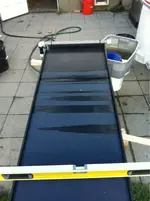425jesse
Hero Member
- Joined
- Feb 10, 2013
- Messages
- 588
- Reaction score
- 819
- Golden Thread
- 0
- Location
- Mountlake Terrace
- Detector(s) used
- 4" Dalke Original Compact Dredge, 36" BGT Prospector, 30" BGT Sniper, D&D/Brawn Super Concentrator and Highbanker top, Brawn/D&D finishing table, pans and more!
- Primary Interest:
- Prospecting
- #1
Thread Owner
I have been running my home made finishing sluice thru the cons I get from a local river. When I pan the cons that I have not run thru the sluiceI seem to get maybe 3 or 4 specs per pan, when I pan the final cons I also get 3 to 4 flakes per pan. I am running my sluice at about 3/4" per foot, and my riffles are 1/8" tall. I use enough water to keep the whole sluice covered in an even flow(sluice slick plate clears in about 25 seconds). I know I am loosing gold, and end up panning everything I run thru the sluice because I want to see what I'm loosing. Any thoughts on how to capture more and loose less?





 !!!! That's not a finishing sluice, that's bigger than my dredge!
!!!! That's not a finishing sluice, that's bigger than my dredge!